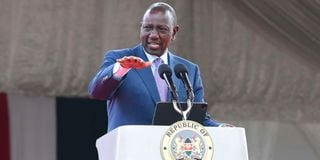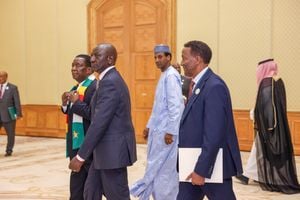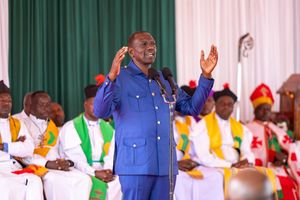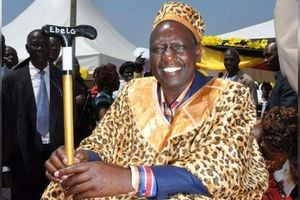
President William Ruto.
President William Ruto’s two years in office have been characterised by major contradictions as he appears to make U-turns on some of the public declarations he made in the run-up to the 2022 General Election. The President has also contradicted himself on policies he made while in office. Some of the about-turns have happened barely two months after the initial stance, exposing him as having no firm position and as a master of double-speak.
Dr Ruto has so far contracting himself on the activities of the Ford Foundation, political persecution of Deputy President Rigathi Gachagua, alleged abductions and kidnappings of individuals perceived critical of his Kenya Kwanza administration, defiance of court orders, co-opting of the opposition figures in government, among other things he vowed he would not entertain.
Gachagua is facing impeachment threats from some of Dr Ruto’s close allies. The embattled second-in-command has publicly lamented of deliberate efforts to undermine him by junior officers in government. He has also claimed a scheme to use security agencies to blackmail him and his allies.
“The use of the criminal justice system to manage politics is an outdated political strategy. President Ruto and I, on assuming office, gave an undertaking to the people of Kenya that never again shall the criminal justice system be called upon to help in the management of politics. I am embarrassed that we are back to where we were,” Gachagua said on Thursday.
This even as he claimed plans to prefer trumped-up charges against three members of his staff as well as MPs James Gakuya (Embakasi North) and Benjamin Gathiru (Embakasi Central. In the run-up to the polls, Dr Ruto vowed not to allow his DP to be humiliated as it happened to him under President Uhuru Kenyatta. “I would not allow my Deputy President to be humiliated the way former deputy presidents have been humiliated and the way I have been humiliated,” said Dr Ruto.
Humiliated
In an interview with NTV, he offered: “I want to tell you that it will never happen. I want to tell you that I will not allow my deputy to be humiliated by junior staff.” In an interview last week, Gachagua lamented: “Even if there is a jinx around this position, at least President Ruto was allowed to do his job for five years without interruption or harassment. I’ve only done one year and what is happening to me is worse than what happened to Ruto. I ask the President to please allow me to work for the next three years.”
While in New York, the President praised the Ford Foundation for safeguarding the country’s democracy, barely two months after he accused the organisation of financing the nationwide youth-led protests that forced him to withdraw the contested Finance Bill, 2024, and the subsequent dissolution of his Cabinet. “Kenya appreciates the Ford Foundation’s commitment to safeguarding our democracy and supporting Kenya's calls for reforms in the global economic institutions, climate action and modern technology regulation. Held talks with the President of the Ford Foundation Darren Walker,” Dr Ruto said on Tuesday.
Read: First Russia, then politicians and now Ford Foundation: Who really is behind the youth protests?
In July, Dr Ruto had linked the foundation to the Gen Z protests. He accused it of causing anarchy and trying to roll back the country’s democratic gains. “We ask the Ford Foundation to explain to Kenyans its role in the recent protests. We will call out all those who are bent on rolling back out hard-won democracy…,” he said in a public address in Nakuru County.
Foreign Affairs Principal Secretary, Korir Singoei, alleged that those funded to destabilise the country included Africa Uncensored Limited (Project Mulika, US$250,000), Women’s Link Worldwide (US$ 750,000), Centre for Resource Mobilization and Development (US$ 20,000), Transform Empowerment for Action Initiative (US$ 220,000), Kenya Human Rights Commission (US$ 600,000), Open Institute Trust (US $100,000), Africa Centre for Open Governance (US$ 200,000) and Transparency International (US$ 300,000).
“Ruto’s penchant for U-turns has made predicting him a soothsayer’s nightmare. His constant, perpetual and unending about-turns reinforce his leadership as indecisive, unprincipled and ad hoc,” said Prof David Monda, a university lecturer and political analyst. “Ruto is a pragmatist. That is to say, he will do whatever he feels is expedient at the moment to get him ahead. A boogeyman had to be found for the unexpected rise of the Gen Z uprising. So he blamed the Ford Foundation,” he added. Jubilee Secretary-General Jeremiah Kioni told The Weekly Review that Kenyans should expect more U-turns on major policies. He claimed that the President is engaged in quick fixes, which entails contradictions of earlier declarations. “When you are a liar you need to have a good memory. He is a liar who underestimates the intelligence of the people of Kenya,” said Kioni.
At the height of his fallout with President Kenyatta, Dr Ruto sustained a narrative that it was because of the March 8, 2018 ‘Handshake’ between the former President and Odinga that Jubilee was unable to deliver on its agenda in the second term. He took the narrative to an internal platform when, during his Chatham House address in London in March 2022, he described the Jubilee administration as ‘a mongrel’.
Ruling party
“Today in Kenya, we have a mongrel of a system. You don’t know whether it is the government that is in opposition or the opposition is the one that is in government. The leader of the opposition is a project of the system and the deep state of the government. Unfortunately, the leader of what is supposed to be the ruling party is actually a squatter or a refugee in the opposition party. If we had built our engagements around political parties we wouldn’t have ended in the situation we are in today where we have opposition members chairing government committees,” said Dr Ruto. But when he dissolved his Cabinet following protests, Dr Ruto incorporated five opposition figures in his new team. They are Opiyo Wandayi (Energy and Petroleum), John Mbadi (National Treasury and Economic Planning), Hassan Joho (Mining and Blue Economy), Wycliffe Oparanya (Cooperatives and MSMEs) and Beatrice Askul (EAC and Asal). He swore Azimio would not be a backdoor shareholder of the KK government. But he has relented, seeing his plunging popularity.
Dr Ruto has also found himself on the spot over alleged abductions, especially during the youth-led protests. He had vowed to stop extra-judicial killings. But the Law Society of Kenya has raised concerns over the rising cases of abductions. At the height of the protests, several individuals, including mobilisers, facilitators and social media influencers have faced threats of abductions. Two Kitengela brothers, Jamil and Aslam Longton, alongside activist Bob Njagi, who were recently released after 32 days of abduction, by people believed to be police officers, have since become poster boys of the latest fate of abductions.
Dr Ruto has, however, insisted that there are no abductions being undertaken by his administration. “I gave my undertaking to the country that there would be no disappearance of Kenyans. There will be no Kenyans in River Yala, there will be no Kenyans in Tana River,” the President said recently. “There was a time we had over 30 bodies of Kenyans in rivers that will never happen under my watch. If there is any Kenyan who has disappeared, I want people to step forward and say so and so has disappeared, I will be very happy to deal with it.” But even Gachagua has complained about the emergence of abductions. On June 26, in an address from Mombasa, the DP recalled how the President promised that Kenyans would be free from State-sanctioned abductions.
“Sadly, this is back. It is unbelievable that the son of the Attorney-General of Kenya was abducted commando-style by officers of the National Intelligence Service and held incommunicado for 18 hours,” said Gachagua. Interior Cabinet Secretary, Prof Kithure Kindiki, on Thursday, told the National Assembly Committee on Administration and Internal Security that a total of 1,208 people were arrested during the anti-government protests, 42 people died, two bodies are still unaccounted for in mortuaries and 132 were reported missing during the same period.












